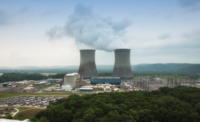The Tennessee Valley Authority this week plans to begin pouring the concrete foundation for a 12,000 sq ft building that the designer is calling a “finger of God build.”
The reinforced concrete building is meant to withstand a 10,000-year earthquake. “We hope we don’t see it tested, but if it is we hope it stays,” says Robert Feiel, project engineer for Mesa Associates, Knoxville.
The diverse and flexible coping capability building, or FLEX, was developed by the U.S. Nuclear Regulatory Commission from the lessons learned in nuclear plant safety as a result of the Fukushima Daiichi accident in 2011. It provides an additional layer of protection beyond the backup systems that were designed for the plants. “It’s an entirely new layer of protection to be used for a beyond design flood, earthquake or tornado,” says Jim Hopson, a TVA spokesman.
Friel says the structure's design is beyond anything that could be possible and still could be used to shut down the plant safely. It addresses the loss of power that crippled the reactor cooling systems that were the fatal flaw at Fukushima.
Mesa has designed the FLEX buildings at TVA’s Watts Bar and tktktkt plants in Tennessee and at Brown's Ferry in Alabama and PPL’s Susquehanna unit in Pennsylvania.
The Watts Bar building must withstand winds of 360 mph and the assault of “tornado missiles,” including a 4,000-lb vehicle traveling at 230 ft per sec., flying utility poles and 12-in. pipes, says Travis Smith, Mesa's lead structural engineer. “The intent is to take the impact and not be perforated,” he says.
The walls are 18-in. thick reinforced concrete and the roof is 16 in. of solid concrete on a 3-in. metal deck. The 18-in concrete and steel door has a 10-in. sacrificial buffer slab that can be replaced if damaged, Smith says. “It’s a military grade blast door,” he says.
The building at Watts Barr will house two 3-MW diesel generators with a 12 X 14-ft intake with missile shields and labyrinth walls, says Smith.
Of particular concern at Watts Bar is the potential for soils to settle 9-inches during a 2 times frequent scale earthquake. “A normal slab on grade would not be capable of supporting that much settlement,” Smith says.
The company chose a micro pile foundation in which 5-in. to 9-in. steel pipes were drilled to the bedrock and grouted in 12-in. and 15-in. sleeves to accommodate the lateral load specification of 1-in. or less. The micro piles were embedded in a 3.5-ft- thick concrete cap.
NRC required the FLEX building at Watts Bar to be built before issuing an operating license for the site's second unit, says Neil Gannon, leader of TVA’s Fukushima enhancement projects. TVA is completing a unit there that was mothballed in 1985 at about 80% completion. TVA began completing construction in 2007. It is expected to come online in December 2015.
The Browns Ferry’s FLEX building must be completed by next spring, Gannon says. It is designed to withstand 300-MPH winds. The difference in requirements is based on the specifications in place when the plants were designed.
The buildings are basically civil structures that have lighting, sprinklers and air conditioning to keep the temperature between 50 deg and 100 deg.
They will house the portable equipment that will be needed to protect the site from the loss of offsite power and emergency generators and provide the water needed to cool the core, the containment unit and the fuel in the spent fuel storage, Gannon said.
The response to the 10,000-year event is based on time, according to Gannon. During the first six hours after an event, unit operators must respond with portable equipment and personnel with the assumption that the site is not accessible.
During the first 24 hours, access to the site is returned and equipment can be brought in from offsite locations. The standard deployment includes 17 tractor-trailers full of equipment stored in a regional response center in Memphis that will be taken to staging areas 25 miles from the nuclear site, Gannon says.
The cost for the FLEX buildings is between $32 million and $38 million per reactor, Gannon says. There are three reactors at Brown's Ferry and two at Watts Bar and two at Sequoyah where construction also is beginning.
The total cost of the Fukushima response is between $224 million to $266 million, according to Gannon.
Kiewit is the general contractor for the Watts Bar and Browns Ferry buildings.



Post a comment to this article
Report Abusive Comment